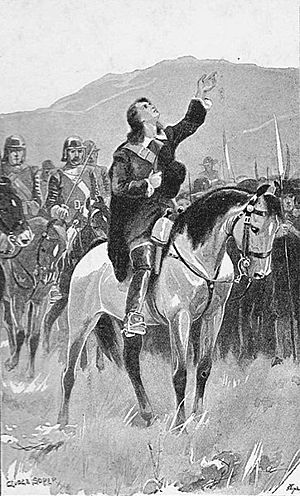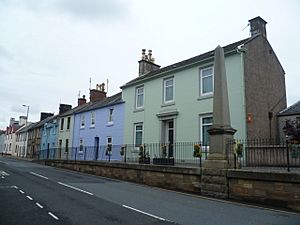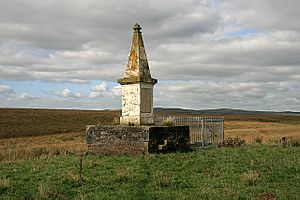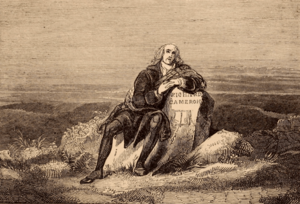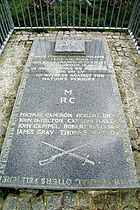Richard Cameron (Covenanter) facts for kids
Richard Cameron (born around 1648 – died July 22, 1680) was an important leader of a group called the Covenanters. These were Scottish Presbyterians who strongly believed in their faith. They resisted attempts by the kings of Scotland, from the Stuart family, to control the Church of Scotland. The kings wanted to use bishops to run the church, which the Covenanters disagreed with.
In 1680, Richard Cameron tried to bring new energy to the Covenanter cause. However, the authorities found him, and he was killed in a fight at Airds Moss in Ayrshire. His followers later became known as the Cameronians. This group eventually formed the basis of a famous Scottish army regiment, the Cameronians, which was active until 1968.
Contents
Richard Cameron's Early Life
Richard Cameron was born in Falkland, Fife, either in 1647 or 1648. His parents, Allan and Margaret Cameron, were farmers. He studied at St Salvator's College at the University of St Andrews, starting in 1662.
After finishing his studies, he returned to Falkland. He worked there as a school teacher and a precentor (someone who leads the singing in church) around 1669 or 1670. Around this time, he started attending conventicles. These were secret outdoor church meetings held by Covenanters because their regular churches were controlled by the king.
In 1675, Richard, his brother Michael, and his parents were called to court. They were accused of holding conventicles and not going to the official church. We don't know the exact result, but they likely paid a fine. Soon after, the family moved to Edinburgh.
Becoming a Preacher
In Edinburgh, Richard Cameron met John Welwood, a traveling preacher. Welwood encouraged Cameron to become more active in his faith. For a short time in 1675, Cameron worked as a private chaplain for a noblewoman. However, he was fired because he refused to attend the official church on Sundays.
With Welwood's help, Cameron became a licensed field preacher in 1678. This meant he could preach at the outdoor conventicles.
The Church Conflict and Indulgences
Between 1669 and 1672, King Charles II offered two "Indulgences." These were special permissions meant to bring many dissenting ministers back into the official Church of Scotland. About a third of the ministers had been forced out.
While some ministers accepted the new rules, which meant accepting bishops and the King as the head of the church, Cameron and others refused. They believed this went against their Presbyterian principles. Cameron spoke out against these Indulgences in his sermons. He was asked three times by church leaders to be "careful and not offensive."

In early 1679, facing pressure from ministers who had accepted the Indulgences, Cameron traveled to the Netherlands. Many other Covenanter exiles were there.
Key Events of 1679
The year 1679 was full of conflict between the Covenanters and the government. It included the killing of Archbishop Sharp, the Rutherglen Declaration, and the battles of Drumclog and Bothwell Bridge.
In the Netherlands, in late July or early August, Cameron became an ordained minister of the Church of Scotland in Rotterdam. A few weeks later, he returned to Scotland. Another Indulgence had been granted and accepted by the church's General Assembly. Cameron wanted to inspire the Covenanters after their recent defeats. He continued his outdoor preaching, writing that he was "received with more affection and joy than ever before."
The Sanquhar Declaration
In March 1680, Cameron joined Donald Cargill, another exile from Rotterdam. They helped create a "band" (a promise of mutual defense) that 27 followers signed. This group became the core of Cameron's supporters.
By April, the Scottish Privy Council (a group of royal advisors) reported to James, Duke of York. James worried that Covenanter meetings were "fore-runners of rebellion." The Council planned new actions against these "fanatics" who were "running out again to field-conventicles."
On June 22, 1680, Cameron and 20 followers rode into the town of Sanquhar. Among them was David Hackston, who was wanted for his part in the murder of Archbishop Sharp. At the town's market cross, after singing a psalm, Michael Cameron read aloud the Sanquhar Declaration. This declaration called for war against King Charles II, calling him a "tyrant." It also demanded that his openly Catholic brother, James, be prevented from becoming king.
The Privy Council responded on June 30. They called the declaration an "execrable paper" (a terrible document) and a declaration of war. They declared the participants "open and notorious traitors and rebels." A reward of 5,000 merks was offered for Cameron's capture.
The Battle of Airds Moss
In the weeks that followed, Cameron continued to preach to growing crowds in southwest Scotland. On July 22, he was in east Ayrshire with about 60 followers. Government soldiers, called dragoons, led by Andrew Bruce of Earlshall, found them at Airds Moss near Cumnock.
Around four in the afternoon, a fierce battle began. Cameron's followers, known as the 'Hill Men', were outnumbered. Bruce reported that "The dispute continued a quarter of an hour very hot; the rebels, refusing either to fly or take quarter, fought like madmen..." Richard Cameron was killed on the spot. Hackston was captured.
Cameron's head and hands were cut off and taken to Edinburgh. They were shown to his father, who was already in prison in the city's tolbooth. When his father saw them, he kissed his son's head and said, "I know them. They are my son's, my own dear son's. It is the Lord. Good is the will of the Lord, who cannot wrong me or mine."
Hackston was paraded through the main street with Cameron's head on a pole. Two days later, Hackston was executed at the cross. Cameron's head and hands were then put on display at the Netherbow Port for everyone to see.
The time when these events happened was later called "The Killing Time." During this period, many Presbyterians were persecuted and died for their Covenanter beliefs.
Richard Cameron's Legacy
In 1689, William II became king and allowed more religious freedom. Cameron's followers were pardoned. They were then made part of the British Army as the Cameronian regiment. This regiment later defeated Jacobite forces in the Battle of Dunkeld. The troop was later renamed the 26th (Cameronian) Regiment of Foot. It served the British Crown until it was disbanded in 1968.
Royalists and moderate Presbyterians saw the Cameronians as very strict and fanatical. However, the Cameronians saw themselves as following the example of early Christian martyrs. They believed they were holding strong to their beliefs against cruel enemies. Their sacrifices for their Protestant faith greatly influenced later generations of Scots. This influence still affects many people in Scotland today.
Some historians see their struggle as a fight for religious and civil freedom against a king who inherited his power. They view it as an early example of ideas about a republic (a country without a king or queen).
The strong religious feelings inspired by the Cameronians can be seen in a poem called The Cameronian's Dream. This poem kept their memory alive long after these events. The author, James Hyslop, was a shepherd from the Cumnock-Sanquhar area. This area was important for the Covenanter uprisings. Hyslop wrote the poem between the ages of fourteen and eighteen, and it was published in 1821. The poem ends with a Cameronian's vision on the lonely moor at Airds Moss.
See also


